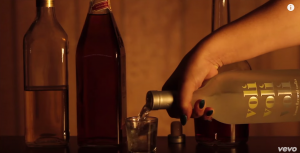
If you haven’t heard of YouTube, you could be accused of having lived under a rock for the last decade. The streaming service, which hosts everything from homemade video clips of cats to big production music videos has over a billions users, which equates to almost a third of all individuals using the internet. In 2014, “Music” was the most searched term on YouTube, with music videos being most popular among younger audiences, the so-called “YouTube Generation”.
The placement of tobacco products in music videos is banned in the UK under the Tobacco Advertising and Promotion Action (TAPA) 2000. Guidelines for placement of alcohol products are less rigorous with the Advertising Standards Authority (ASA) requiring only that “Marketing communications for alcoholic drinks should not be targeted at people under 18 and should not imply, condone or encourage immoderate, irresponsible to anti-social drinking”.
However, whilst evidence has revealed that young adults’ exposure to tobacco (Morgenstern et al, 2013) and alcohol (Sargent et al., 2006) imagery in TV and film can lead to initiation of smoking and drinking, there is little known about the alcohol and tobacco content of online music videos. Initial research suggests music videos contain substantial alcohol and tobacco imagery (DuRant et al, 1997; Cranwell et al, 2015) and promote branding in a positive way (Roberts et al, 1999), indicating the need for future research in this area.
The present study (Cranwell et al (2016) therefore aimed to examine the extent to which adults and adolescents are exposed to alcohol and tobacco content in YouTube music videos by estimating population exposure.

Research shows that tobacco and alcohol imagery in TV and film can lead young adults to start smoking and drinking.
Methods
Video content data
Tobacco and alcohol content were coded using semi-quantitative coding. A sample of 110 YouTube videos were analysed. These were videos in the UK top 40 from Sunday 3rd November 2013 – Sunday 19th January 2014.
Alcohol and tobacco content was coded as using the following criteria, coded in either visual imagery or lyrical content in successive 10 second intervals.
- Actual use
- Implied use
- Paraphernalia
- Brand appearances
These exposure categories were combined to give a single measure of alcohol or tobacco content in each 10 second interval. The 32 most popular videos by chart position containing either tobacco or alcohol content were included in the survey data analysis.
These 32 videos comprised 821 ten-second intervals for analysis, of which 47 were tobacco-related and 233 were alcohol-related. Electronic cigarettes were present in 6 intervals.
Survey data
Exposure to the 32 videos was assessed in adolescents and adults using an online survey carried out by YouGov PLC.
The survey of adolescents, carried out in conjunction with Action on Smoking and Health (ASH) included:
- 1,010 males and 1,158 females
- Aged 11-18
- Surveyed between 21st March – 1st April 2014
The adult survey included:
- 1,052 males and 1,180 females
- Aged ≥ 19
- Surveyed on 14th – 15th July 2014
Surveys were designed to be representative by age, gender, region, social grade and newspaper readership (for adults).
Participants in the survey were asked if they had ever seen each of the 32 videos.

This research focused on 32 music videos in the UK Top 40 chart that contained alcohol or tobacco content.
Results
Analysis
Survey data were combined from the adolescent and adult surveys to estimate the proportion of the UK population, broken down by age and gender that had seen the 32 videos in a 12 week period. Video content was analysed for number of alcohol and tobacco 10 second intervals in each video, to estimate the number of images/depictions/lyrics (impressions) of alcohol and tobacco content.
Exposure
- The proportion of adolescents who had seen the 32 videos was 22% (95% CI 0.19 to 0.26) and 6% for adults (95% CI 0.04 to 0.08)
- Videos delivered a total of 1,006 million impressions of alcohol (95% CI 748 to 1,264) and 203 million impressions of tobacco (95% CI 151 to 255)
- The majority of impressions were delivered to 25-34 year olds, but impressions were nearly four times higher for adolescents in terms of exposure to tobacco and alcohol content compared to adults
Tobacco impressions
- The highest exposure to tobacco impressions was in adolescents aged 13 to 15 at 11.48 impressions (95% CI 9.83 to 13.14), compared with 10.50 impressions in 16-18 year olds (95% CI 8.44 to 12.56) and 2.85 impressions in adults (95% CI 2.06 to 3.64)
- Exposure to tobacco impressions in adolescents was around 65% higher in females compared to males. The highest number of tobacco impressions were delivered to females aged 13-15 years
Alcohol impressions
- Exposure to alcohol impressions followed a similar pattern to tobacco by age and gender, however the number of impressions was approximately 5 times higher for alcohol compared with tobacco
- The estimates suggested that adolescents had 52.11 alcohol impressions (95% CI 43.36 to 60.86) compared with adults who had 14.13 impressions (95% CI 10.21 to 18.05)
- The highest exposure to alcohol impressions was in females aged 13-15, with individual exposure at 70.68 impressions
Individual videos
- Music videos were from a range of countries; 21 from Britain, 11 from USA, 4 from Netherlands, 3 from Sweden, 3 from Canada and 1 from New Zealand
- The highest number of tobacco impressions for the whole population was from the video “Trumpets” by Jason Derulo, with a total of 36.80 million gross impressions (95% CI 32.31 to 41.30), with 12.27 million (95% CI 11.46 to 13.09) of these delivered to adolescents. The same pattern was found for “Love me again” by John Newman and “Blurred lines” by Robin Thicke which delivered the second and third most tobacco impressions. These videos delivered more impressions to adolescents compared with adults.
- The highest number of alcohol impressions were generated by the video “Timber” by Pitbull (featuring Ke$ha) delivering a total of 162.59 million impressions (95% CI 145.47 to 179.7), including 44.47 (95% CI 41.7 to 47.22) million delivered to adolescents. The same video also delivered 7.52 million tobacco impressions (95 % CI 7.05 to 7.98) to adolescents compared with 2.40 million impressions (95% CI 2.11 to 2.69) to adults.
- A similar patterns of alcohol impressions were found for “The Best Song Ever” by One Direction and “Drunk in Love” by Beyoncé. These videos delivered the second and third most alcohol impressions, and delivered more impressions to adolescents compared with adults.

These results show that YouTube music videos are an effective mechanism for exposing adolescents and adults to tobacco and alcohol impressions.
Summary
- The present study demonstrates that in a sample of 32 music videos, which were the most popular in the UK over a 12 week period, 1.2 billion 10 second intervals containing either tobacco or alcohol content were delivered to adolescents and adults.
- Approximately, one third of these impression were delivered to 11-18 year olds. The number tobacco and alcohol impressions delivered to young people was almost four times of that in adults. Impressions for girls were higher compared to boys.
Interpretation and implications
As the authors point out; if these figures were typical for a one year period, music videos would be responsible for delivering over four billion alcohol impressions and almost one billion tobacco impressions in Britain alone. Together with previous research, this suggests that music videos are a global medium for exposing adolesecents and adults to tobacco and alcohol imagery.
Tobacco and alcohol cues in films and TV have both been shown to be powerful cues that guide smoking initiation and early alcohol use in adolescents (Morgenstern et al, 2013; Sargent et al., 2006). Furthermore, for adults who regularly drink or smoke, alcohol and tobacco cues can motivate further continued use (for a review see Carter and Tiffany, 1995). Therefore given the health implications of drinking and smoking it seems intuitive that portrayals of alcohol and tobacco use be subjected to regulatory control.
At present, tobacco paid-for-placement is banned in the UK and alcohol promotion is somewhat regulated. The current findings reflect this legislation, with higher impressions observed for alcohol versus tobacco content. Previous studies have reported that music artists often have overt associations with alcohol companies, which may include paid-for alcohol content in their music videos (Cranwell et al, 2015). These findings suggest that greater restraint for alcohol content in particular is required for regulating lyrics, imagery and branding in music videos.
Potential limitations of the present study include the selection of music videos. Whilst the selected videos reflected the top 40 selling songs for a given 12 week period, it did not mean that these were the most watched on YouTube. The authors also acknowledge the limitation of “coverage bias” in their survey method, where some groups of society may have been underrepresented.

Is greater regulatory control the answer?
Conclusion
This study indicates that YouTube is a powerful medium for delivering impressions of tobacco and alcohol content in music videos to both adolescents and adults alike.
Previous research has suggested that exposure to such alcohol and tobacco cues can impact initiation and maintenance of smoking and drinking behaviours.
These findings therefore indicate that a review of regulation concerning tobacco and alcohol content of music videos is both deserved and timely.
Links
Primary paper
Cranwell J, Opazo-Breton M, Britton J. (2016) Adult and adolescent exposure to tobacco and alcohol content in contemporary YouTube music videos in Great Britain: a population estimate. J Epidemiol Community Health doi:10.1136/jech- 2015-206402. [Abstract]
Other references
Carter and Tiffany (1999) Meta-analysis of cue-reactivity in addiction research.
Cranwell et al (2015) Adolescent’s exposure to alcohol and tobacco content in YouTube music videos. [PubMed abstract]
DuRant et al (1997) Tobacco and alcohol use behaviours portrayed in music videos: A content analysis. [PubMed abstract]
Morgenstern et al (2013) Smoking in movies and adolescent smoking initiation: longitudinal study in six European countries. [PubMed abstract]
Roberts et al (1999) Substance use in popular movies and music. [Abstract]
Sargent et al (2006) Alcohol use in motion pictures and its relation with early-onset teen drinking. [PubMed abstract]
Photo credits


RT iVivekMisra Alcohol and tobacco in YouTube music videos: young female teenagers most… https://t.co/oF9JQuNjdX … https://t.co/69PAIzsuBZ
Today @SallyScientist looks at impact YouTube music videos can have on smoking/drinking behaviour of teenagers https://t.co/O4tD7tz8ld
Should we review the regulation of tobacco & alcohol content of music videos? https://t.co/O4tD7tz8ld
Today I blog for the @Mental_Elf on Alcohol and Tobacco content in YouTube music videos https://t.co/iKVO7IRRHJ
Alcohol and tobacco in YouTube music videos: young female teenagers most exposed https://t.co/O4tD7tQJcL #YoungMindsMatter
New study investigates how adults & adolescents are exposed to alcohol & tobacco content in @YouTube music videos https://t.co/O4tD7tz8ld
Alcohol and tobacco in YouTube music videos: young female teenagers most exposed https://t.co/CzgPfUqf1U via @sharethis
This is a very interesting read though I have to say I am a little disappointing that some more of the study’s potential weaknesses don’t seem to have been picked up by either the study authors or this blog. I have to admit that when I first saw this blog mentioned on twitter this morning and after quickly reading the blog I was reminded of the “research” that was carried out in the 80’s that led to the Video Recordings act and commented that “As a child of the era, reminds me when ‘video nasties’ were going lead to a generation of psychopaths or something “. Though I have to say my intention was mostly satirical the point stands that the study authors haven’t really addressed some potential weaknesses in their study. I note firstly that they haven’t included a copy of their survey, so though difficult to judge one can only be left with the impression that the questions were simply of the type “have you seen this video by Beyonce?”… Now we know from the VRA debacle and Guy Cumberpatch’s debunking of the research that informed it that if you ask a child/adolescent if they have seen something then (due to a bandwagon effect) a significant proportion of the respondents are going to lie and say they have when they haven’t and will also lie about the number of times they have seen something. There are myriad different reasons for this and scores of cognitive biases that can have an effect, but beyond an acknowledgement of coverage bias in their survey and the limited selection of videos none of this has been addressed, which makes the conclusion that “greater restraint for alcohol content in particular is required for regulating lyrics, imagery and branding” sound awfully like a call for censorship of artistic expression to me.
Fags & booze on @YouTube What impact is it having on our children? https://t.co/O4tD7tz8ld
Don’t miss – Alcohol and tobacco in YouTube music videos: young female teenagers most exposed https://t.co/O4tD7tz8ld #EBP
RT @iVivekMisra: Alcohol and tobacco in YouTube music videos: young female teenagers most… https://t.co/UpgOepm40o #MentalHealth https://t.…
[…] 1Alcohol and tobacco in YouTube music videos: Mental Elf […]
[…] films are not the only platform via which exposure to smoking imagery may occur. Young people are frequently exposed to cigarette smoking via TV and music videos. Therefore methods of preventing and/or controlling exposure may need to be widened beyond the […]